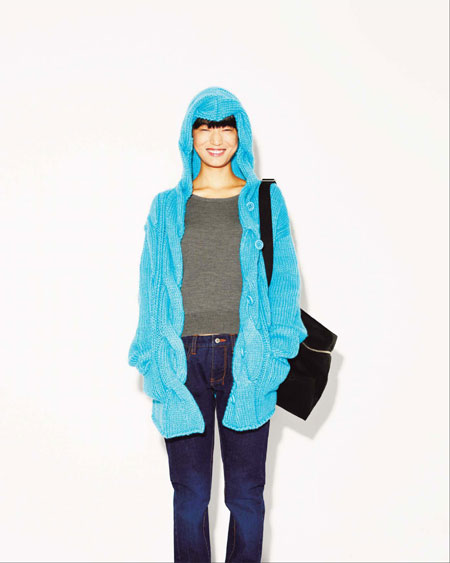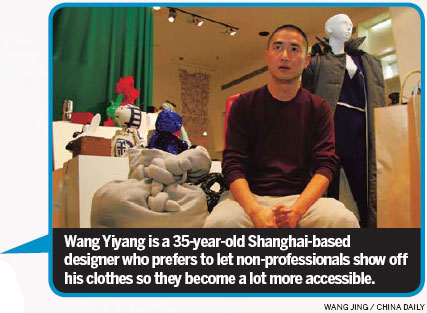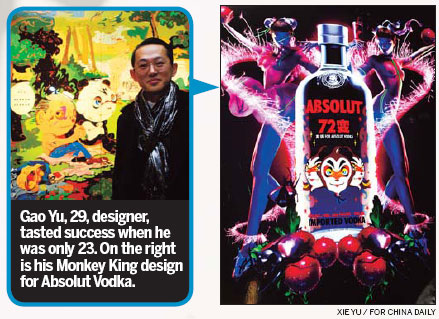Pride of China
By Chen Nan (China Daily)
Updated: 2010-11-21 10:17
 |
Large Medium Small |




A new breed of young designers is breaking the molds and making their own rules in design and fashion. Chen Nan turns on the spotlight on some exceptional examples.
High rent, predatory competitors and a relatively uninformed consumer crowd would discourage most tender new entrants to the fashion business. Not so for a handful of new Chinese designers, who are upending conventional notions of Chinese design, making rapid commercial success and turning from unknown to renowned in a short time.
Wang Yiyang, a 35-year-old Shanghai-based designer, is one of them.
He has his edgy print dresses, asymmetric jackets and twisted accessories priced from $30 to $500 hanging from his boutiques at Shin Kong Place in Beijing, City Plaza in Shanghai and more than 40 branches in 30 cities across the country. His stores are designed with a simple, gallery-style backdrop that dovetails with his designs.
Recently, Wang gave a speech at the Ullens Center for Contemporary Art (UCCA), located in Beijing's avant-garde 798 arts district. He entranced the audience with the inside story on career building and fashion interpretation.
"More Chinese fashion designers have emerged in the highly competitive markets in the country and even abroad, launching successful lines that are snapped up by the best stores," he said at the speech. "From my experience, you need to be patient but adventurous."
Wang studied clothes design at Donghua University in Shanghai, and won a design contest in 1997. He became the lead designer for Layefe under Yifei Finery, a fashion label launched by the late Chinese artist Chen Yifei, known for his $300,000 oils.
Faced with fame at such an early age, Wang realized he needed his own platform after working five years at Layefe. He established his own brand, Zuczug, in 2002, drawing inspiration from his hometown, Changchun, capital city of Jilin province, and the 1970s, the era he grew up in.
The critical and commercial success that followed encouraged the launch of another brand, Cha Gang, two years later - a brand now considered Shanghai's most representative local label.
"There is no doubt the years from 1970s to 1990s played a big role," the designer says. He used the symbols of that time, such as the long army coat and chagang, a common water jug used by almost everyone then.
"I see people changing their styles along with the progress in society, and I express my responses to these changes through my works," he says.
One of Wang's trademarks is that he rarely uses professional models but ordinary people, which he sees as one way to get fashion back to the man or woman in the streets.
Wang says he is lucky to have a ready platform even before starting his own brand. He also encountered problems at the beginning.
"Cities like Shanghai have high rents, which discourages boutiques from working with emerging designers," he says. "They reason they'd be safer buying established brands.
"It's really risky to open a store of your own, especially when you are a young, unknown designer. But for designers, having a store is always a dream. It's like a singer wanting to sing on stage."
Applying his design sensibility and his experience built up from working at Layefe, Wang overcame financial limitations and became specialized in women's wear. His latest collection, called Catch Me, also expands product lines to include notebooks and purses. The limited edition of the notebook, blue on the cover with a white rabbit, has been sold out since it was released in September.
Wang's work is representative of the new breed of Chinese designers whose creative outpourings are steeped more in big-city sophistication than in any cultural heritage or in imitating the West.
Gao Yu, 29, whose fashion label, GG, brought the young designer commercial success when he was only 23, had his painted series Under the Red Flag sold at Christie's auction in Hong Kong for nearly HK$200,000 ($25,791).
In 2006, his collection, Don't Understand and Can't Guess Clearly, sold at a Sotheby's auction for nearly HK$300,000, setting an all-time record among his peers in Asia.
"I thought about working at a film company when I graduated because it's really hard for an art student to find a job in the art field," the Sichuan Fine Arts Academy graduate says. "I didn't know what to do then."
In spring 2003, an accidental shopping trip gave birth to the central character in his business. Gao bought a toy panda and gave it a name, GG. When he decided to draw it, he gave the panda an angry, rebellious look.
The commercial success story continues. In August, a 130-year-old Swedish vodka brand signed Gao up to the latest line, titled 72 Transformations, a China-only redesign of the brand's iconic bottle.
The theme is rooted in Chinese mythology, in the story of the Monkey King of the 16th-century Buddhist allegory, Journey to the West. The Monkey King has the ability to transform himself 72 different ways, hence the theme.
Using the cartoon medium does not limit Gao's creativity.
"Anyone familiar with traditional Chinese culture is able to find familiar re-interpreted stories and characters in my work," he says. "Some may question, saying 'How can you interpret China's national treasure in that way?' But I say, that's my perspective.
"The role of designer, in a Western sense, is new to China. But I always think that this is a country that once invented gunpowder, wrought iron, the compass, paper, silk and the toothbrush. People want to see original Chinese designers and their works, which are exclusively Chinese."
Beijing is a confluence of styles and it is where you can have antiques at the Panjiayuan flea market, Prada, Chanel and Louis Vuitton at all the major malls.
There is still a comparative vacuum when it comes to representative young designers, but it is a space that is slowly filling up.
A scattering of independent boutiques has emerged to help fill that void. Art centers such as UCCA have opened a shop to sell products. Small stores are popping up at Beijing's hutong, such as Nanluoguxiang, and big retail stores are adding local designers to their shelves.
"China is a creative hub. This is where you come for ideas, where people push the boundaries," says Hong Huang, author, television talk-show host and magazine publisher, who broke new ground with the opening of a 540 square-meter shop in Sanlitun Village, Beijing. Brand New China (BNC) gathers about 150 young Chinese designers, showcasing their clothes, accessories and furniture.
"We can tell the buying power is huge from the revenue from the luxury market. The creativity and aspirations of individual designers are rising. You can see their designs penetrating every corner of our lives, from a lighter to a car," she says.